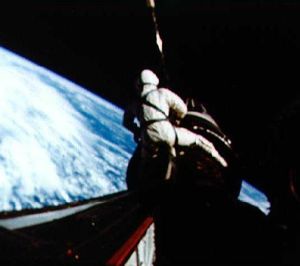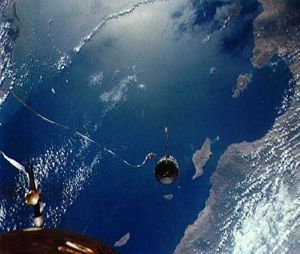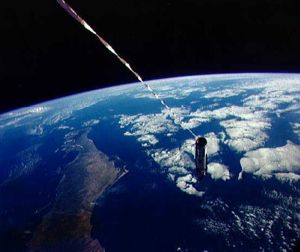It looks like you're using an Ad Blocker.
Please white-list or disable AboveTopSecret.com in your ad-blocking tool.
Thank you.
Some features of ATS will be disabled while you continue to use an ad-blocker.
4
share:
I realise the International Space Station was designed for experiments in a number of disciplines to be conducted in a 0G environment, but as they
seem to spend an inordinate amount of time studying the growing list of ailments that humans suffer in those conditions, I wonder why NASA has not
conducted, as far as I know, any experiments with producing artificial gravity by way of spinning even a scale model of a rotating space station? Or
maybe just a pod on either end of a long wire of sufficient length to produve 1G. It doesn't look like humans will ever have a healthy future in 0G,
so why the lack of interest? Don't they want humans heading off on long journeys, or is there some technical reason that makes rotation too
difficult?
Von Braun envisioned a rotating station, as did Kubrick of course, and NASA does mention them, but not an intention to use or at least experiment with them.
Wheels in the sky:
science.nasa.gov...
Von Braun envisioned a rotating station, as did Kubrick of course, and NASA does mention them, but not an intention to use or at least experiment with them.
Wheels in the sky:
science.nasa.gov...
There are some problems with rotating space stations. For example:
The problems are not insurmountable but at this point they outweigh the desirable aspects of creating "artificial gravity" by spinning the station. Besides, it's known that it would work in situations where it would be desirable.
- Orbital maneuvering (a occasional necessity) becomes tricky
- It's nice to have instruments and communications links (and windows) pointed in a more or less consistent direction
The problems are not insurmountable but at this point they outweigh the desirable aspects of creating "artificial gravity" by spinning the station. Besides, it's known that it would work in situations where it would be desirable.
edit on 7/2/2012 by Phage because: (no reason given)
You also need a relatively big space station to get it to work. Otherwise the gradient across you will make you yack like a sick cow. Consider: if
your head were at the axis and your butt at "1G", it's going to feel pretty damned odd. Even if you get it big enough that the gradient doesn't bother
you, there's sort of an inbetween point where you're still getting weird visual cues about what "up" is that conflict with what the seat of your pants
tells you. More yack, at least until you get used to it, some people don't deal well with visual/labyrinth discord.
Also, it imposes a pretty big structural requirement. In free fall, the station doesn't need to be that structurally sound. The only acceleration you need to survive is that imposed by your OMS. If you spin for acceleration, you've got to have beefy designs to keep the thing from flying apart.
There's other issues, tumbling and precession problems with weight imbalances, for example.
edit to add: a rotating space station can also make docking really exciting. Not to mention space walks involving the outer periphery.
Also, it imposes a pretty big structural requirement. In free fall, the station doesn't need to be that structurally sound. The only acceleration you need to survive is that imposed by your OMS. If you spin for acceleration, you've got to have beefy designs to keep the thing from flying apart.
There's other issues, tumbling and precession problems with weight imbalances, for example.
edit to add: a rotating space station can also make docking really exciting. Not to mention space walks involving the outer periphery.
edit on
2-7-2012 by Bedlam because: (no reason given)
I agree with what Phage said, but would also add that besides the scientific benefits of studying micro-gravity, it's also great fun!
I'd feel a bit cheated if I went into space and didn't get to float around and play with liquids in micro-gravity.
I'd feel a bit cheated if I went into space and didn't get to float around and play with liquids in micro-gravity.
edit on 2-7-2012 by
FireballStorm because: (no reason given)
reply to post by GaryN
There is a concept for a centrifuge demonstrator module for the ISS: ISS centrifuge demonstration
There are no plans to actually make it as of yet, but it is being looked at by some. Due to its small size, it wouldn't be able to produce 1g though.
There is a concept for a centrifuge demonstrator module for the ISS: ISS centrifuge demonstration
There are no plans to actually make it as of yet, but it is being looked at by some. Due to its small size, it wouldn't be able to produce 1g though.
Good posts all around in this thread. NASA tried a couple of experiments to generate artificial gravity on the flight of
Gemini XI in September, 1966. The idea was to tether the nose of the capsule to the Agena
docking module, then play out the line and attempt to produce "gravity" by two different means.

The results were decidedly mixed. The problem was the non-rigid connection. The small amount of "gravity" induced was not enough to overcome the inertia of the two heavy counterweights, and both spacecraft flopped around considerably.


Read the above link, starting ~4/10ths of the way down for details.
Overall it was a highly successful flight that included the first rendezvous on the first orbit after launch (necessary - or at least highly desired - for the Apollo lunar liftoffs), an altitude record that included flight through the lower Van Allen Belts, stellar photography, and the first computer-controlled re-entry (also, by accident, the first time a spacewalker (and his commander) fell asleep during EVA).
A very brief film clip of the of the tether experiment can be seen at 5:18 in this newsreel:

The results were decidedly mixed. The problem was the non-rigid connection. The small amount of "gravity" induced was not enough to overcome the inertia of the two heavy counterweights, and both spacecraft flopped around considerably.


Read the above link, starting ~4/10ths of the way down for details.
Overall it was a highly successful flight that included the first rendezvous on the first orbit after launch (necessary - or at least highly desired - for the Apollo lunar liftoffs), an altitude record that included flight through the lower Van Allen Belts, stellar photography, and the first computer-controlled re-entry (also, by accident, the first time a spacewalker (and his commander) fell asleep during EVA).
A very brief film clip of the of the tether experiment can be seen at 5:18 in this newsreel:
reply to post by Bedlam
I'd imagined just aircraft wire (though I know there is better stuff now) for the 'rim' and a mylar or multi-layer film tube for the habitable area. Using some of Buckminster Fullers super strong but lightweight designs should do the job. A heavy hub, maybe a water storage facilitiy, should provide some stability.
I remember 40 years ago or so, going on a fairground ride where they spin a group of people in a barrel, vertical axis, I think there was room for at least a dozen, and then move the floor down so you are stuck to the wall. It was weird, but after a short while most people could stand up, heads all towards the axis, and do some pretty simple movements. The ride attendents were the experts of course. So yes, weird with a small diameter, but I'd think fairly easy to adjust to if it were a couple of hundred feet dia.
Yes, many challenges, but for long missions, or voyages, I'd think it was still the way forward. Guess I'm disappointed, being a long time SF fan, that no plans seem to be on the drawing board.
@Saint Exupery
Agreed! And thanks for the info about Gemini, I was not aware of that experiment with rotation. Have to look to see what reports there were on that, and any conclusions.
If you spin for acceleration, you've got to have beefy designs to keep the thing from flying apart.
I'd imagined just aircraft wire (though I know there is better stuff now) for the 'rim' and a mylar or multi-layer film tube for the habitable area. Using some of Buckminster Fullers super strong but lightweight designs should do the job. A heavy hub, maybe a water storage facilitiy, should provide some stability.
You also need a relatively big space station to get it to work. Otherwise the gradient across you will make you yack like a sick cow. Consider: if your head were at the axis and your butt at "1G", it's going to feel pretty damned odd.
I remember 40 years ago or so, going on a fairground ride where they spin a group of people in a barrel, vertical axis, I think there was room for at least a dozen, and then move the floor down so you are stuck to the wall. It was weird, but after a short while most people could stand up, heads all towards the axis, and do some pretty simple movements. The ride attendents were the experts of course. So yes, weird with a small diameter, but I'd think fairly easy to adjust to if it were a couple of hundred feet dia.
There's other issues, tumbling and precession problems with weight imbalances, for example.
Yes, many challenges, but for long missions, or voyages, I'd think it was still the way forward. Guess I'm disappointed, being a long time SF fan, that no plans seem to be on the drawing board.
@Saint Exupery
Good posts all around in this thread.
Agreed! And thanks for the info about Gemini, I was not aware of that experiment with rotation. Have to look to see what reports there were on that, and any conclusions.
reply to post by jra
This is interesting because I hasn't heard about this, like ever. I've spoken to a few people over at NASA in the past few years and as well with my Astronomy / Physics teachers and none knew about something like this when I had posed the question about "when will it happen?" But as far as I can tell, this may have been proposed last year some time (from the sources on wiki), so there's quite some time to go and for the cost of $3.7bn, it's not going to go so well unless it's internationally funded. NASA's funding keeps getting cut (unfortunately) and $3.7bn if I remember correctly is more than a third of its funding per year.
I hope this is a green light project
This is interesting because I hasn't heard about this, like ever. I've spoken to a few people over at NASA in the past few years and as well with my Astronomy / Physics teachers and none knew about something like this when I had posed the question about "when will it happen?" But as far as I can tell, this may have been proposed last year some time (from the sources on wiki), so there's quite some time to go and for the cost of $3.7bn, it's not going to go so well unless it's internationally funded. NASA's funding keeps getting cut (unfortunately) and $3.7bn if I remember correctly is more than a third of its funding per year.
I hope this is a green light project
reply to post by jra
Thanks for that link jra, another page I hadn't seen before. Good to know there is something on the drawing board at least. I'd like to see the rotating module built and tested, as I also was wondering if our bodies would recognise artificial gravity as 'real'. Maybe it also would sense the Coriolis force and not behave as if we were in a 'genuine' gravity field?
Thanks for that link jra, another page I hadn't seen before. Good to know there is something on the drawing board at least. I'd like to see the rotating module built and tested, as I also was wondering if our bodies would recognise artificial gravity as 'real'. Maybe it also would sense the Coriolis force and not behave as if we were in a 'genuine' gravity field?
new topics
-
Flee from idolatry
Religion, Faith, And Theology: 4 hours ago -
FIEND SLASHED: Sara Sharif’s killer dad ‘has neck & face sliced open with jagged tuna tin lid
Mainstream News: 4 hours ago -
Musk calls on King Charles III to dissolve Parliament over Oldham sex grooming gangs
Mainstream News: 5 hours ago -
Grenfell Tower Fire revisited
Mainstream News: 6 hours ago -
The Why Files Lacerta Reveals the Truth of our Creation
Aliens and UFOs: 6 hours ago
top topics
-
Congress Says the FBI is Covering Up Vital Info on the Jan 5th 2021 D.C. Pipe Bombs at RNC-DNC.
Political Conspiracies: 15 hours ago, 15 flags -
Musk calls on King Charles III to dissolve Parliament over Oldham sex grooming gangs
Mainstream News: 5 hours ago, 13 flags -
The Why Files Lacerta Reveals the Truth of our Creation
Aliens and UFOs: 6 hours ago, 10 flags -
Grenfell Tower Fire revisited
Mainstream News: 6 hours ago, 7 flags -
So, what is really going on in South Korea ?
World War Three: 15 hours ago, 6 flags -
FIEND SLASHED: Sara Sharif’s killer dad ‘has neck & face sliced open with jagged tuna tin lid
Mainstream News: 4 hours ago, 6 flags -
Watts home paranormal activity
Paranormal Studies: 14 hours ago, 5 flags -
Flee from idolatry
Religion, Faith, And Theology: 4 hours ago, 3 flags
active topics
-
The Why Files Lacerta Reveals the Truth of our Creation
Aliens and UFOs • 3 • : putnam6 -
Musk calls on King Charles III to dissolve Parliament over Oldham sex grooming gangs
Mainstream News • 34 • : Oldcarpy2 -
Vehicle Strikes people in New Orleans
Mainstream News • 285 • : xuenchen -
Ukraine halts transit of Russian gas to Europe after a prewar deal expired
Political Conspiracies • 122 • : Oldcarpy2 -
Orbs Appear And Form Triangle On Live Cam.
Aliens and UFOs • 9 • : alldaylong -
Elon Musk Calls for Tommy Robinson to be Freed - and Takes a Dig at Starmer
Politicians & People • 11 • : gortex -
FIEND SLASHED: Sara Sharif’s killer dad ‘has neck & face sliced open with jagged tuna tin lid
Mainstream News • 15 • : Oldcarpy2 -
Why Such An Uproar Over Non-US Citizens With H1-B Work Visas.
Social Issues and Civil Unrest • 164 • : grey580 -
Flee from idolatry
Religion, Faith, And Theology • 3 • : charlest2 -
Biden to award Presidential Citizens Medal to Liz Cheney and Bennie Thompson
US Political Madness • 15 • : WeMustCare
4
